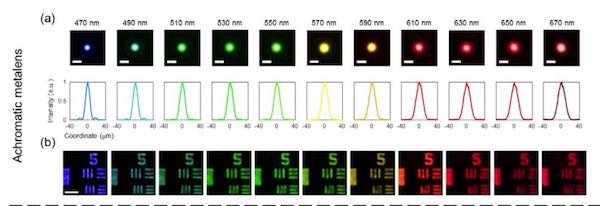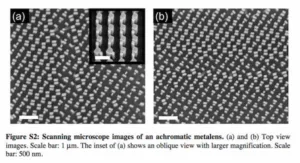The new publication ‘A broadband achromatic metalens for focusing and imaging in the visible‘ by scientists from Harvard (John A. Paulson School of Engineering and Applied Sciences as well as the Department of Physics) and University of Waterloo, Canada, describes a new approach in creating a thin optical element that could be used in many electronic display applications including augmented and virtual reality headsets. The group of Wei Ting Chen, Alexander Y. Zhu, Vyshakh Sanjeev, Mohammadreza Khorasaninejad, Zhujun Shi, Eric Lee and Federico Capasso has worked in this field before, as described below.
Instead of using diffractive properties of transparent materials they are placing small objects on a transparent wafer to manipulate the passing wavefront. The results are the continuous efforts of the same group from the past that were described in their paper ‘Achromatic Metalens over 60 nm Bandwidth in the Visible and Metalens with Reverse Chromatic Dispersion Metalens with Reverse Chromatic Dispersion‘ from earlier in 2017. While the earlier work worked in reflection and achieved a 60nm bandwidth the new results are achieved in transmission and with a larger bandwidth range from 470nm to 670nm.
The metalens is based on objects with a size of the same order of the wavelength being placed on the transparent wafer. The following image shows a scanning microscope image of the structures. The structure seem to be made from TiO2 as in their earlier work.
The results are quite encouraging and are shown in the second image below.
 Achromatic Metalens Shows Focus for the all Wavelength in the Visible RangeIt is clear that this approach seems to work as expected and provides a thin lens that can focus all wavelength in the visible spectrum at the same time without spatial multiplexing or cascading. The paper describes the development of the pattern and the achieved experimental results. It also discusses that this is just a first trial and that the optical performance still needs to be improved.
Achromatic Metalens Shows Focus for the all Wavelength in the Visible RangeIt is clear that this approach seems to work as expected and provides a thin lens that can focus all wavelength in the visible spectrum at the same time without spatial multiplexing or cascading. The paper describes the development of the pattern and the achieved experimental results. It also discusses that this is just a first trial and that the optical performance still needs to be improved.
Analyst Comment
As with many new developments today, connecting the research to the technology flavor of the day is sure to attract the interest of potential investors. This is exactly what happened as many news outlets described this as a development for VR headsets. While this very encouraging work, we have to keep in mind that this is just R&D at this point. The optical performance is not good enough for consumer devices and there is no idea on how to make these devices in high quantity at reasonable prices. On the other hand I would not be surprised if we see this technology eventually being used on the $10 AR headsets we will pick up at the local supermarket. When this will happen is still up in the air. (NH)
Metalens are widely seen as a potential alternative to the fresnel lenses currently used in VR headsets. We recently saw a useful introduction to lenses for VR by Tom’s Hardware.

